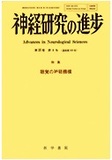Japanese
English
- 有料閲覧
- Abstract 文献概要
- 1ページ目 Look Inside
I.緒言
聴器や前庭器官などにおいて,感覚有毛細胞と求心神経との接続が化学的シナプスを介して行なわれていることは今日よく知られている。しかし,それは主として形態学上の知見に基づくもので,そのような微細形態の解明がますます精緻を加え,また電気生理学的な研究も単一求心神経の発射や有毛細胞の受容器電位についての研究が盛んに行なわれるのに比較し,それらの間を連絡するシナプス機序についての知見は非常に乏しい現状である。その主な理由は聴神経線維が概して細く,細胞内記録による分析が困難であることに帰せられるが,その結果として有毛細胞の求心シナプスは単に受容された情報を忠実に求心線維に伝える働きをするだけのものとされ,無関心の状態に放置されているようである。それと比べると,聴器に対する遠心シナプス作用についての関心のほうがずっと高いといえる。
私どもはキンギョの聴器(小嚢)より発する求心神経線維の直径が大で,安定な細胞内記録が可能であることを利用して,聴器の働作の種々の様相,とくに感覚有毛細胞と聴神経線維間の求心シナプスにおける伝達機構を種々調べてきているが,ここではわれわれがキンギョの聴器について得ている知見に基づいて,どこまで蝸牛における単一求心発射の特性を説明できるかということに重点を置いて述べたい。
Abstract
In the ear as well as in other hair cell organs, effects of stimulus received by sensory cells are transmitted to afferent fibers through a chemical synapse. Despite wealth of informations on its ultrastructural details, however, knowledges on the mode of operation of hair cell-afferent fiber synapse have been very scarce. One either as-sumed simply that the afferent synapse conveys informations received by sensory cells faithfully to afferent fibers where they are transformed to the frequency code, or was forced to seek analogy in other synapses, such as neuromuscular junctions or spinal motoneurons.

Copyright © 1981, Igaku-Shoin Ltd. All rights reserved.


